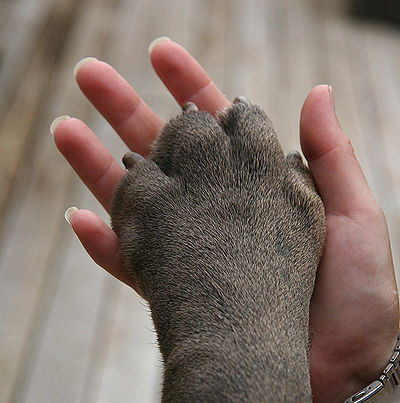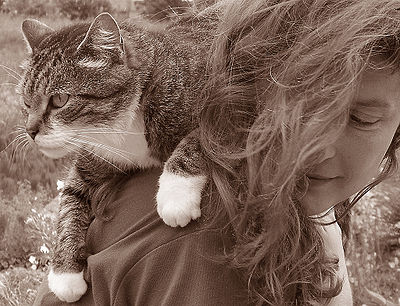
Your cat’s and dog’s paws should be checked regularly, daily if they spend lots of time outdoors.
If your pet limps, that’s a sure sign that something is wrong. Burrs or other foreign bodies can get stuck between toes. Sometimes they are so deeply embedded they are hard to see. These can be gently removed with a tweezer. Check paw pads for any cuts, burns or cracks. Wash gently with an antibacterial soap and dry well. Ask your vet for instructions if the cuts are bleeding or very tender.
Cats normally will keep away from hot surfaces. But taking your dog for a walk or a run on hot pavement can burn paw pads, creating blisters and/or infection. Try walking or running your dog early in the morning or later in the evening to avoid the heat of the day. If possible walk or run your dog on dirt or grassy areas – they don’t absorb as much heat as pavement and can be cooler.
Keep your pet’s nails trimmed. Regular trimming of your cat’s nails will save your furniture too. Trimming your dog’s nails makes him much more comfortable for walking and will help ease any leg problems. It’s a good idea to get your pet used to your handling of his paw. Some pets are very sensitive and rebel at this. Try running your hands gently over the entire body including legs and paws regularly. You can supply treats when handling their paws and praise them. I also discovered that teaching my dogs to shake hands helped them get over the fear of having their paws touched.
Winter brings with it other paw problems. Salt and de-icers thrown on the ground to melt ice and snow can irritate your pet’s paws. Ice may cling to the fur. But there is help.
There are boots available that will protect your pet’s paws. Trim the fur between the toes and around the paws to prevent ice from clinging. You can rub some oil, ie. vitamin E oil, vaseline, canola oil or olive oil on the pads and between the toes. This will help to keep paws from cracking and makes cleanup easier. And if your pet licks the oil, that’s okay, it’s good for him. However try not to let your pet lick its paws until you’ve carefully removed any de-icer with warm water as it can be toxic.
Have you ever wondered how your dog happily runs through the snow and ice? Scientists have found that dogs have blood vessels in their paws that help protect them from the cold. The blood is warmed by a network of veins and then flows back into the body. The temperature in the dog’s paws remains constant. However, in frigid weather, it’s wise to take precautions to prevent harm to the dog’s paws.
Watch for constant licking of paws. It can be an indication of pain and should have the attention of your vet.
Being prepared for the weather can save your pet discomfort and pain and you can save on vet bills. See more: Help Your Pet Stay Warm in Winter



